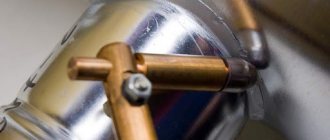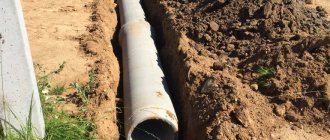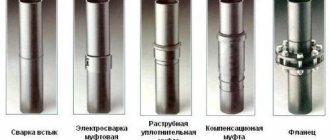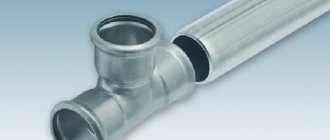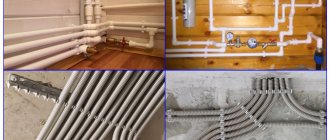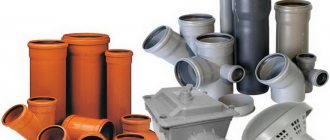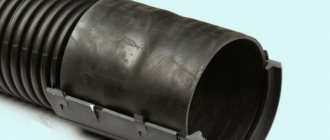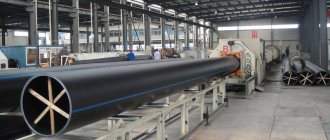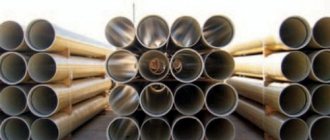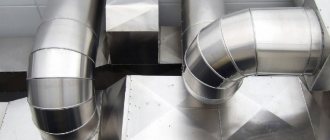In order for the water supply systems and the circuits through which the coolant circulates to flawlessly cope with their responsibilities, their components must be correctly assembled and correctly connected. The result of the plumbers' efforts must be airtight so as not to create problems for the owners and their neighbors. Do you agree?
All current methods of connecting pipes that ensure normal operation of the system are given in our proposed article. We have described in detail the technological options depending on the material from which the articulated parts are made and the category of the pipeline. Our tips will help you achieve the perfect result.
Socket connection method
A socket is a mounting extension designed to create a reliable connection. The principle is based on the fact that the end of a pipe with a smaller cross-section is inserted into a pipe of larger diameter. The connection is sealed by using a sealant placed in the socket or gluing with a composition that is resistant to water.
This type of connection is used when installing gravity pipelines for both internal and external sewerage systems, pressure external water pipelines and sewer networks.
Depending on the material of the pipes and their diameter, one of several existing options for socket joints is selected: with a sealing ring, without a ring, welding, gluing.
Connection without ring seal
Cast iron pipes are most often connected without an O-ring. The inserted pipe is shortened, the end is processed so that there are no nicks or mother-in-laws left in it. The tail part of the articulated pipe is inserted into the socket.
The resulting gap is filled with oiled hemp rope or tarred linen strands. First, the seal is placed in a ring and caulked into the socket by tapping it with a hammer on a special wooden spatula or screwdriver. It is important to ensure that the ends of the material do not get inside the pipeline.
Continue laying the sealant layer by layer until the socket is filled to 2/3 of its depth. For the last layer, an untreated sealant is used, because oils or resins will impair adhesion when filling the remaining space in the socket with cement.
To obtain the solution you need cement grades 300 - 400 and water for diluting it. The components are taken in a ratio of 9:1. The cement is compacted into the socket and covered with a wet rag for better setting.
The best quality seal is to use expanding cement. It is prepared just before use by adding water to a container with the main component in a 2:1 ratio, followed by thorough mixing and pouring into the socket. When hardened, the cement compacts itself and becomes completely waterproof.
Sometimes, instead of cement, an asbestos-cement mixture is used, made from M400 cement and high-quality asbestos fiber in a 2:1 ratio.
Water is added immediately before laying in an amount of about 11% by weight of the dry mixture. Instead of cement-based sealants, they use bitumen, silicone sealants, clay, the last layer of which is strengthened by applying bitumen or oil paint.
Socket connection with O-ring
This method is most often used when installing an intra-house sewer system. A rubber ring sandwiched between the socket and the pipe inserted into it creates a tight connection. Therefore, the method is not only simple, but also reliable.
The sealing ring to some extent smoothes out the differences in axes between the two pipes being connected. However, this is only the case if the axes on each meter of the composite pipeline are shifted by an amount that does not exceed the limits of the pipe wall thickness.
If this condition is violated, then the likelihood of leaks as a result of uneven deformation of the seal increases.
The procedure for connecting pipes with a socket. The parts to be joined are cleaned of dirt and dust. To avoid damaging the O-ring during installation, the smooth end of the pipe is pre-lubricated with soap, glycerin or special silicone grease. Oils cannot be used for this purpose. In addition to lubrication, a chamfer made at the connecting end of a pipe of smaller diameter at an angle of 15⁰ will protect the ring from damage.
To determine the depth of pressing of the free pipe shank into the socket, the sealing ring is temporarily removed. Then, placing the pipe in the socket until it stops, mark the place where the inserted part comes into contact with the socket.
During installation, the pipe is pushed out slightly in relation to the mark - by 0.9 - 1.1 cm. This distance will balance the internal stresses that appear in the system during temperature fluctuations.
Before placing the ring, it is recommended to dip it in soapy water and squeeze it a little. This will greatly simplify its insertion into the recess of the bell. In order to minimize the amount of misalignment, some manufacturers began to produce fittings with an angle of 87⁰ instead of 90⁰. The pipe enters the socket at an angle and the ring does not warp.
If there is a need to connect pipes made of different types of materials, adapter pipes are used. The size of the pipe, such as the internal diameter, must correspond to the outer section of the connected pipe. If the socket of a polymer pipe is connected to a cast iron pipe, a double seal is applied to the end of the second one and the pipe is mounted.
Pros and cons of metal-plastic products
Metal-plastic has characteristics that make it possible to create reliable systems with a service life of 15 to 50 years. The outer diameter of the products is 16-63 mm. The fittings must fully match the diameter of the pipes, while the wall thickness (2-3 mm) must also be taken into account.
For internal wiring, the most optimal diameter is 32 mm. Water is supplied to heating devices most often through narrower products - from 22 mm to 24 mm.
The joining of two metal-plastic pipes occurs through fittings, which also have different diameters, differ in installation method, purpose and configuration. Material of manufacture – stainless steel and brass
Metal-plastic pipelines can withstand temperatures up to +95ºС (with interval increases up to +110ºС), therefore they are used for assembling heating systems. There is a threshold at which pipes freeze - this is -40ºС. Working pressure – 1 kPa. When the temperature decreases, the pressure can increase without the risk of system destruction up to 2.5 kPa.
Advantages of metal-plastic pipelines (when compared with analogues made of metal, PVC and polypropylene):
- Quick installation. To connect individual sections, no welding or soldering is required; keys or a special crimping tool are sufficient.
- There is no need to coat it with protective paint with an anti-corrosion compound.
- Systems with permanent connections are designed for installation in screeds or walls.
- The weight of pipes and fittings is light, which also facilitates installation in various ways.
- During installation, a minimum of waste is generated.
- Protected from stray currents.
- Pipelines with detachable connections are easy to repair and replace fittings.
- They have the ability to connect additional devices without disassembling the entire system.
- Using special fittings they are combined with metal pipes.
There are also disadvantages, and they must be taken into account when installing the wiring yourself. The cost of MP pipes is quite high, and accordingly, fittings are more expensive. You can compare the characteristics of metal-plastic and polypropylene pipes by reading our recommended article.
If the temperature of the liquid in the heating pipeline is constantly maintained at the maximum (+95ºС), the service life of the pipeline is reduced by half. The polymer layer is destroyed by sunlight, therefore, the pipes should not be in the area exposed to ultraviolet radiation.
Bonding parts of a plastic pipeline
PVC pipes are connected to a socket using the gluing method. For better adhesion, the socket inside and the tail of the inserted pipe are sanded to make the surface rough. Next, the chamfer is removed, and the treated parts are degreased using methylene chloride as a primer.
Before making a connection, check the pipes for compatibility. A pipe of smaller diameter should fit into the socket freely, but not too much. Then a line marks the boundary for applying glue - this will help to join the parts without errors.
On the surface of the elements being connected - 2 thirds of the socket recess, as well as the fully calibrated end of the pipe, glue is evenly applied in a thin layer. The pipe is inserted into the socket and turned a quarter turn to improve contact between the elements being connected. The joined parts are held until the glue sets.
Special aggressive adhesives are used for gluing polyvinyl chloride pipes. The process is similar to welding, but without high-temperature exposure; it is replaced by a chemical reaction, as a result of which the surfaces of the connected parts of the pipes are dissolved and transformed into one whole by copolymerization
The process takes only 20-30 seconds. If a uniform layer of glue appears at the joint, it is immediately removed using a piece of clean cloth. From gluing to complete stabilization of the connection and testing the pipeline for leaks, at least a day should pass.
Image gallery
Photo from
PVC pipes for bonding
Treating pipes before joining
Rules for applying glue to PVC parts
Joining glued parts
To repair existing pipelines, shaped parts are used in the form of repair couplings or products with an extended socket. A section of pipe is cut out, the ends are chamfered, and special glue is applied to the ends. The coupling is placed on the bottom of the pipeline.
A coupling with a long socket is placed on the top of the pipeline until it stops; if required, a shaped part is mounted on it. Move the coupling along with the shaped part down until it connects with the bottom of the pipeline. The sliding coupling is moved upward so that it covers the joint area.
A repair coupling differs from a regular coupling in that it does not have a side inside, so during the repair process the bell of any pipe can be moved through it
If even after this there is a leak, the joint is filled with silicone sealant. The bottom and top are determined depending on the direction of movement of the transported substance.
Varieties
Shaped parts are divided according to several criteria. The following types of products are distinguished by form:
- A full bore coupling is a straight cylinder that is designed to connect tubes of the same diameter. The thread is located inside.
- Nipple - a fitting with an external thread, designed to temporarily connect two pipes that have a fitting.
- A transition coupling is two cylinders connected by a truncated cone. Suitable for joining pipes of different diameters.
- Adapter - fitting with internal thread. It is needed to create a connection between tubes that have different locations of threaded notches.
- Transition nipple - the thread is located on the outside. Designed to connect pipes of different sizes with fittings attached to them.
- A tee is a coupling that has additional pipes. Threaded notches may differ on different pipes. Used for making additional pipeline branches and connecting household appliances.
- Angle - can be with either internal or external thread. Designed to change the direction of the water supply system.
- Crosspiece - suitable for connecting multiple outlets or household appliances.
- A fitting is a nut that has one pipe.
Secondary connecting parts include fittings, fittings, and tube plugs.
The following classification applies to the materials that are used to make fittings:
- metal parts;
- plastic products.
Steel fittings are resistant to high pressure and high temperatures. The same cannot be said about plastic parts.
Steel threaded fittings
Formation of threaded connections
A thread is a spiral or helical surface used to make a threaded connection. The use of threaded pipe connections in plumbing systems is a classic installation method.
It is used where it is possible to periodically monitor the joints, because threads tend to weaken under the influence of various factors.
To connect elements using threads, simply screw in two parts that have suitable cross-sections. They are also easy to disconnect - by unscrewing.
There are different types of pipe threads. Each of them is characterized by such parameters as the profile of the surface on which the thread is applied, direction, location, and number of thread starts.
The list of the most popular types of pipe threads includes:
- cylindrical or Whitward;
- conical;
- round;
- NPSM
The first of them is designated by the letter G and has 2 accuracy classes. The profile visually resembles an isosceles triangle. At the apex there is an angle of 55⁰. They connect pipeline sections with a diameter of up to 6 inches, which are subject to special requirements for tightness, using inch threads. For larger diameters, welding is used.
Inch-type conical threads are used for conical connections and to create joints of conical threads made on the outside and cylindrical inside the pipe. The letter R marks the external thread, the internal thread - Rc, LH - directed to the left. The sealant is the thread itself plus the sealant.
To connect frequently disassembled plumbing fittings: water stop taps, faucets, round threads are mainly used. It is designated by the symbols Kr.
The table summarizes the main thread parameters for a pipe that you can cut with your own hands. An important value for an inch thread is its pitch. This is the distance between adjacent ridges or troughs. Its value along the entire length remains unchanged, otherwise the thread will not work
The NPSM thread profile has a triangle shape and an angle of 60⁰. The size range in inches is from 1/16 to 24. This American standard thread is a type of cylindrical thread. It differs from the domestic one only in the size of the profile angle.
What types of fittings are there?
Fittings are the pipeline elements that are required to connect pipes to each other. So, using these parts, you can join pipes of different sections.
In the manufacture of pipes for supplying various communications, the following materials are used:
- metal;
- polypropylene;
- a combination of two materials - metal-plastic.
You can read about metal-plastic pipes for water supply in our special article.
When choosing suitable connecting elements, it must be taken into account that they must be made of the same material as the pipeline.
Plastic pipes with reinforcement are popular among other products
Criterias of choice
When choosing water pipes for your home, you need to consider:
Options for laying water pipes
Terminology
Some terms may be unfamiliar to the reader who is not familiar with plumbing and therefore require comments.
- A compression fitting either compresses the pipe with a rubber or silicone seal when tightening a union nut with a conical internal cross-section, or uses a split ring to compress the pipe itself onto the fitting (for soft copper and metal-plastic).
- The press fitting reliably fixes the metal-plastic pipe to a fitting with a pair of rubber rings when the stainless steel sleeve is compressed with special pliers.
- Push fitting (from the English push - press) is fixed when pressed. The tightness here is ensured by rubber rings, but a stainless spring ring with tabs directed inward helps in securing it.
When welding polypropylene, a low-temperature soldering iron melts the inner surface of the coupling fitting and the outer surface of the pipe, after which the parts are combined and, after cooling, become a single whole.
Butt welding of polyethylene pipelines looks similar.
- The electrofusion fitting contains a heating coil. By applying power to it, it is possible to force it to heat the polyethylene to the melting point and achieve reliable welding of the parts.
- Cross-linked polyethylene has a mechanical memory and, after stretching the end of the pipe with a special tool, quickly returns to the initial diameter, squeezing the fitting inserted into it. The sleeve placed on top provides additional fixation.
- Threaded connections of metal pipelines are made using cast iron and brass fittings; the threads are sealed with flax fiber (usually with paint) or polymer materials.
It is fundamentally important: in most cases, it is on the threads that various crafts made from plumbing pipes are planned - table lamps, floor lamps, tables, etc. Once painted, these funny designs look fully presentable.
Metal-plastic pipes
The structure of the metal-plastic pipe has 3 layers. Two polyethylene and between them - aluminum. All layers are fixed with an adhesive composition. The complexity of the design ensures a long service life of metal-plastic pipes.
Metal-plastic with a diameter of 16, 20, 26, 32, 40 mm is produced in mass production: with their help, extensive and local water supply distributions and connections to household appliances are formed. Larger diameter pipes (from 50 and above) are used infrequently and only in industry.
MT is characterized by the following properties:
- heat resistance;
- anti-corrosion;
- resistance to aggressive chemicals;
- ease;
- flexibility;
- low electrical conductivity;
- strength;
- oxygen impermeability.
Purpose of metal-plastic pipes:
- heat and water supply, heating;
- transportation of liquid and gaseous substances in various economic sectors;
- in air conditioning systems;
- as protective screens for electrical cables and other wires.
Nuances of choice
For internal cold water supply, you can take any of the above options. For hot water supply, metal-plastic or steel is more suitable. Copper is also good in both cases, but is expensive. For external water supply pipelines, you should choose only steel or polyethylene products. They are not afraid of low temperatures in winter, and if the water in these pipes freezes, they will definitely not burst.
When choosing pipes for water supply, you must also take into account the expansion coefficient of the material at high temperatures.
Auxiliary fittings made of plastic
Plumbing fittings made of polyethylene and polypropylene are used to organize plumbing systems. The main method of connecting plastic elements is welding using a special soldering iron.
When comparing the characteristics of polyethylene and polypropylene fittings, it must be remembered that the latter are more fragile and withstand low temperatures much worse. Their destruction can begin at a temperature of -5 degrees.
Low-pressure polyethylene pipes (LDPE) are used mainly for drainage and sewer systems. Such elements are painted gray. Black and blue pipes are used in water supply systems.
Sewerage
There are much fewer docking methods here.
Cast iron
Traditionally, chasing is used to connect cast iron sewers:
- The pipe is inserted into the socket of the fitting;
- The space between them is tightly caulked with kabalka - oiled organic fiber;
- Then the joint is covered with cement mortar or filled with molten sulfur.
Accordingly, fittings are a combination of bends with the same diameter as the pipes and sockets.
However, new cast iron sewer fittings and pipes are increasingly equipped with rubber seals, ensuring tightness during ordinary joining.
PVC and polyethylene
Both polyethylene and the much more common PVC pipes for sewerage, and fittings for them, are again equipped with rubber seals in the sockets.
There are two subtleties associated with docking:
- It is advisable to remove the outer chamfer from a pipe cut to size. Otherwise, it will be difficult to insert it into the rubber-sealed socket.
- A connection made with sealant is guaranteed not to leak due to drying of the rubber.
Tightness is ensured by a rubber seal; The sealant additionally fixes the pipe and protects against leaks when the rubber dries.
